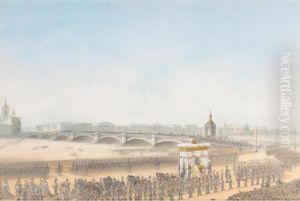Josef Iosefovich Charlemagne Paintings
Josef Iosefovich Charlemagne, also known as Osip Ivanovich Sharlemagne, was a Russian architect and graphic artist renowned for his contribution to the urban development of St. Petersburg during the 19th century. Born on July 24, 1824, in St. Petersburg, Russia, Charlemagne was part of an artistic family. His father, Johann Hermann Charlemagne, was also an architect, and his grandfather, Louis Charlemagne, was a notable engraver, which undoubtedly influenced his early education and career choice.
Charlemagne studied at the Imperial Academy of Arts in St. Petersburg from 1837 to 1849 and was a pupil of the architect Alexander Brullov. There, he honed his skills in architecture and design, winning a gold medal for his graduation project. After completing his studies, he embarked on a study trip to Italy, which was a common practice for artists and architects of the time to refine their craft and draw inspiration from the Renaissance and classical antiquity.
Upon returning to Russia, Charlemagne worked on various projects, including the design and construction of residential buildings, churches, and public amenities. He played a significant role in shaping the architectural landscape of St. Petersburg, blending European styles with Russian traditions. His works often featured elements of the Renaissance combined with Byzantine and Russian-Revivalist styles, contributing to the eclectic architectural character of the city.
Charlemagne was also an accomplished graphic artist, and he produced a significant number of lithographs depicting St. Petersburg's architecture and daily life. These works were important historical records of the city's development during a period of rapid urbanization and industrialization.
Josef Iosefovich Charlemagne's contributions to Russian architecture were cut short by his untimely death on May 3, 1870, in St. Petersburg. Although he died relatively young, his legacy lived on through his buildings and graphic art, which continued to influence Russian architectural aesthetics well into the latter part of the 19th century.
